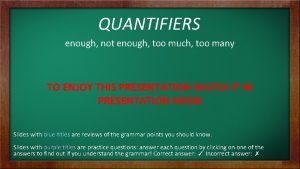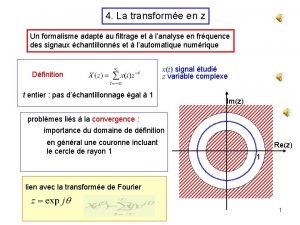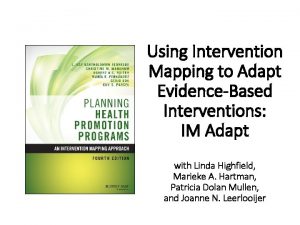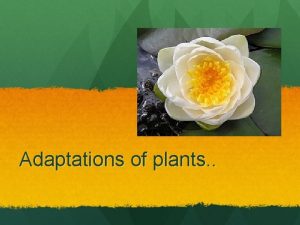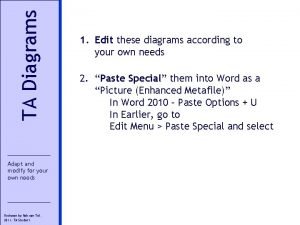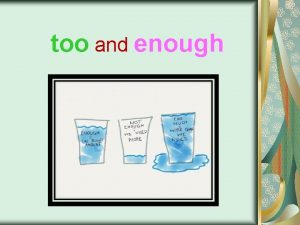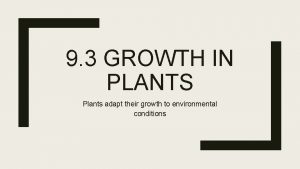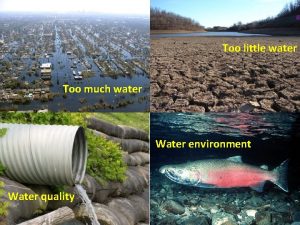Adaptationsin PLANTS Plants can adapt too l Plants




















- Slides: 20

Adaptations…in PLANTS

Plants can adapt too! l Plants have certain adaptations to help them survive (ex-A cactus will store water to survive longer without available rain. )

We all know…. …Plants have roots. l What l Why is the purpose for this adaptation? do roots grow downward?

We all know…. What is the purpose for this adaptation? A plant needs roots for two chief reasons: as a means of anchor age or support, and to absorb water and mineral salts from the soil. l Why do roots grow downward? Roots grow toward and reach for water. l

In Plants… l Plants have xylem l This tissue is responsible for carrying water up the stems of plants to leaves.

Stimulus and Response… l An organisms behaviors are in response to a stimulus from their environment. l. A stimulus is any event or happening that causes a response (ex-Someone calls your name… you turn around)

Regulation l Living organisms regulate their internal conditions to balance their exterior environment. l Homeostasis is like a continuous circle of adjustments and corrections

A Response to Sunlight or Gravity? ? What will this plants roots look like?

Geo + Tropism l. A "tropism" is a plant movement triggered by stimuli. l The term "geotropic" refers to a plant whose roots grow down into the soil as a response to gravity.

Examples…In Plants l Plants control themselves with water

Examples…In Plants l What structure allows water to move through the stem of plants?

Examples…In Plants l What structure allows water to move through the stem of plants? XYLEM

Review. List the organelle with its function l Vacuole l l Membrane l l Cell Wall Nucleus Mitochondria l Cytoplasm

Osmosis & Diffusion…

Osmosis & Diffusion l Solute-A solute is dissolved in another substance, known as a solvent. (Na. Cl or C 6 H 12 O 6) l Solvent- A solvent is a liquid or gas that dissolves a solid, liquid, or gaseous solute, resulting in a solution. (The most common solvent in everyday life is water )

Permeability…. l. A measure of the ability of a porous material to allow fluids to pass through it.

Osmosis & Diffusion l Osmosis is the movement of solvent molecules through a selectively permeable membrane into a region of higher solute concentration, aiming to equalize the solute concentrations on the two sides.

Where is there more salt?

Diffusion describes the spread of particles through random motion from regions of higher concentration to regions of lower concentration.

 Quantifiers kahoot
Quantifiers kahoot Small just
Small just Research questions
Research questions Too foreign for home too foreign for here
Too foreign for home too foreign for here Too much money is chasing too few goods
Too much money is chasing too few goods Too anointed to be disappointed
Too anointed to be disappointed Too broad and too narrow examples
Too broad and too narrow examples Too broad and too narrow examples
Too broad and too narrow examples Not too narrow not too deep
Not too narrow not too deep Adapt synonym
Adapt synonym Acknowledge ask adapt
Acknowledge ask adapt Avoid alter accept adapt
Avoid alter accept adapt Transformée en z
Transformée en z How do arctic wolves adapt to their environment
How do arctic wolves adapt to their environment Adapt it solutions
Adapt it solutions Automf skfuzzy
Automf skfuzzy Adapt size
Adapt size Role play counseling script examples
Role play counseling script examples Http://www.mbgnet.net/
Http://www.mbgnet.net/ Adapt ao
Adapt ao Adapt and modify
Adapt and modify
